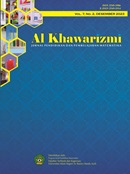Pre-Service Teachers Perceptions and Knowledge in Padangsidimpuan City : Concepts of Trigonometric
DOI:
https://doi.org/10.22373/jppm.v7i2.20718Keywords:
Keywords, Pre-service Teachers, Trigonometric concepts, Teachers perceptions, Teacher knowledgeAbstract
Abstract
This paper explored pre-service teachers’ perceptions and knowledge of trigonometric concepts. Convenience sampling technique was used to select a sample of 200 (50 females, 150 males) second year science/mathematics pre-service teachers from two Colleges of Education in the Padangsidimpuan City. Trigonometry Perception Questionnaire (TPQ) and Trigonometry Assessment Test (TAT) were used to collect data on pre-service teachers’ perceptions and conceptual knowledge of trigonometry. Data were coded and keyed into Statistical Package for Service Solutions (SPSS version 20) and analysed using descriptive statistics. The results suggested that pre-service teachers perceived trigonometry as abstract, difficult and boring to learn; and had limited conceptual knowledge of basic trigonometric concepts. Consequently, more that 65 % of them were unable to construct and reconstruct the appropriate mental structures for meaningful understanding to enable them respond to important basic trigonometry tasks. To achieve quality mathematics education, teacher educators must change their instructional practice and teach for understanding. Since understanding is the key to teacher’s instructional actions, processes and knowledge, we recommend teaching trigonometry for understanding during teacher preparation.
References
Adegboye, A. O. (2000). An Investigation of Students' Perceptions of Chance, Destiny and Miracle as Causative Factors of Performance in Mathematics Examination. Ilorin Journal of Education, 11-23.
Ahamad, S.N.S.H., Li, H.C., Shahrill, M., & Prahmana, R.C.I. (2018). Implementation of problem- based learning in geometry lessons. Journal of Physics: Conference Series, 1503(1), 012008.
Akkoç, H., & Akbaş Gül, N. (2010). Analysis of A Teaching Approach Aiming at Eliminating Student Difficulties with Radian. Journal of Faculty of Educational Sciences, 43(1), 97-129.
Asiala, M., Brown, A., DeVries, D., Dubinsky, E., Mathews, D., & Thomas, K. (1996). A Framework for Research and Development in Undergraduate Mathematics Education. Research in Collegiate Mathematics Education II, CMBS Issues in Mathematics Education, 6, 1-32.
Cetin, O. F. (2015). Student's Perceptions and Development of Conceptual Understanding Regarding Trigonometry and Tigonemetric Functions. Educational Research Reviews, 10(3), 338-350.
Cherry, K. (2017). Perception and The Perceptual Process. (Online), (https://www.verywell.com/perception-and-the-perceptual-process-2795839), retrieved 16 June 2017.
Dubinsky, E. (2010). The APOS Theory of Learning Mathematics: Pedagogical Applications and Results. Paper presented at the Eighteenth Annual Meeting of the Southern African Association for Research in Mathematics, Science, and Technology Education. Durban, South Africa.
Fajet, W., Bello, M., Leftwich, S. A., Mesler, J. L., & Shaver, A. N. (2005). Pre-Service Teachers’
Perceptions in Beginning Education Classes. Teaching and Teacher Education, 21, 717-727.
Gür, H. (2009). Trigonometry Learning. New Horizons in Education, 57(1), 67-80.
Kakraba, S., Morkle, C. E., & Adu, J, K. (2011). The Relationship Between Students’ Perception of Mathematics and Their Mathematics Achievement in Senior High Schools: A Case Study Of Cape Coast Metropolis. Cape Coast: University of Caape Coast.
Klein, M. E. (2015). Teaching Trigonometry Based on The Meaningful Learning Theory and The Conceptual Fied Theory. Konrad Krainer; Na da Vondrov a CERME 9 - Ninth Concregress of the European Society for Research in Mathematics Education, 3169.
Ministry of Education. (2007). Diploma in Basic Educationcurriculum for Designated Science and Mathematics Teacher Training Colleges of Education. Accra, Gh: CRDD-TED.
Ministry Of Education. (2010). Teaching Syllabus for Core Mathematics (SHS). Accra: CRDD.
Moore, K, C. (2012). Coherence, Quantitative Reasoning, And The Trigonometry Of Students. In R. Mayes & L. L. Hatfield, Qualitative Reasoning and Mathematical Modelling: A Drive for STEM Integrated Education and Teaching in Context (pp. 75 – 92). Larmie, WY: University of Wyoming.
Mutodi, P., & Ngirande, H. (2014). The Influence of Students' Perceptions on Mathematics Performance: A Case Study of A Selected High School in South Africa. Mediterranean Journal Of Social Sciences, 5(3), 431-445.
Rizkianto, I., Zulkardi, & Darmawijaya. (2013). Constructing Geometric Properties of Rectangle, Square, and Triangle in the Third Grade of Indonesian Primary Schools. Journal on Mathematics Education, 4(2), 160-171.
Tuna, A. (2013). A Conceptual Analysis of The Knowledge of Prospective Mathematics Teachers About Degree and Radia. World Journal of Education, 3(4), 1-9.
Wasike, A., Ndurumo, M., & Kisilu, K. J. (2013). The Impact of Perception on Performance in Mathematics of Female Students in Secondary Schools in Teso District, Kenya. Journal of Education and Practice, 4(20), 104-110.
Weber, K. (2005). Students' Understanding of Trigonometric Functions. Mathematics Education Research Journal, 17(3), 91-112.
Wongapiwatkul, P., Laosinchai, P., & Panijpan, B. (2011). Enhancing Conceptual Understanding of Trigonometry Using Earth Geometry and The Great Circle. Australian Senior Mathematics Journal, 50(1), 54-64.

